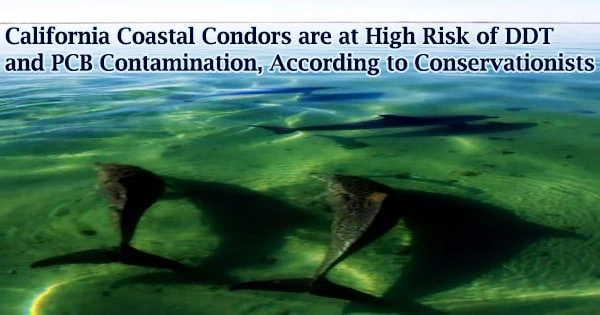Contaminants that were outlawed decades ago are still endangering critically endangered California condors, according to a new research. Because they eat deceased marine mammals around the California coast, condors may be at an elevated risk of reproductive problems.
San Diego State University (SDSU) and San Diego Zoo Wildlife Alliance (SDZWA) scientists discovered that marine mammals stranded on the California coast have relatively high levels of halogenated organic contaminants (HOCs), in collaboration with the Centro de Investigación Cientifica y de Educación Superior de Ensenada and the National Oceanographic and Atmospheric Administration.
In samples taken from stranded marine creatures that California condors may eat, researchers discovered more than 400 pollutants. The marine mammals off the coast of California have seven times the amount of DDT and 3.5 times the amount of PCBs than their counterparts in Baja California, Mexico.
Other, less well-studied chemicals were discovered as well. In comparison to marine mammals in Baja California, one category of these chemicals was predicted to be 148 times more common in California marine mammals.
The study, which was published in the journal Environmental Science & Technology on May 17, also found that coastal condors have higher levels of pollutants in their blood than inland condors, who do not eat marine mammals.
“This kind of broad survey of contaminants shows us that the condors and the marine mammals have a multitude of contaminants that have never really been examined before, especially in detail,” explained corresponding author Nathan Dodder, Ph.D., analytical chemist and research scientist in the School of Public Health at SDSU and the SDSU Research Foundation.
“The non-targeted contaminant analysis we used not only identifies known legacy contaminants, but has the added advantage of identifying novel contaminants, in addition to known but less-examined contaminants that are not routinely screened.”
In the blood samples of the coastal condors, an average of 32 pollutants were found, compared to only eight in the inland condors. DDT and PCBs were found to be seven and forty times more common in coastal condors than inland condors, respectively.
The marine mammals in the Gulf of California presumably have less DDT and other halogenated compounds because there wasn’t a historic discharge or dumping off of the coast like we see in Southern California.Our study highlights the value of the Baja California site because it provides this habitat where the food may not have as many contaminants in it.
Margaret Stack
Coastal condors had high levels of the pollutant TCPM, but inland condors had none. TCPMOH, a closely comparable pollutant, was found to be 56 times more common in coastal condors than in inland condors.
“TCPM and TCPMOH are associated with DDT, but understudied in terms of their abundance in marine wildlife and toxicity,” said study co-author Eunha Hoh, Ph.D., professor in SDSU’s School of Public Health. “This is the first research to find these compounds in the California condors.”
Despite the fact that HOCs were outlawed decades ago, they are very resistant to environmental degradation and continue to accumulate in marine food webs, potentially harming marine species physiologically.
Many of these chemicals, such as DDT and PCBs, are endocrine disruptors, and data suggests that exposure to HOCs in scavenged marine animal carcasses causes eggshell thinning in coastal condors.
“The marine mammals in the Gulf of California presumably have less DDT and other halogenated compounds because there wasn’t a historic discharge or dumping off of the coast like we see in Southern California,” added co-author Margaret Stack, research specialist at the SDSU Research Foundation.”Our study highlights the value of the Baja California site because it provides this habitat where the food may not have as many contaminants in it.”
Condors in California were virtually extinct a few decades ago, but because to massive breeding and reintroduction efforts, their number has been slowly rebuilding. Ingestion of lead pieces from land animals shot with lead ammunition is still the leading cause of death for inland California condors.
Because there are more marine mammal carcasses for condors to eat along the coast, there is a lower danger of exposure to lead, making coastal environments ideal for condor reintroduction. However, pollutants discovered in the carcasses of marine mammals may represent a new hazard to the endangered birds.
“The goal of the recovery program is to have condors throughout their historical range, which starts in the Pacific Northwest and ends in Baja California,” said co-author Ignacio (Nacho) Vilchis, Ph.D., associate director of recovery ecology at SDZWA. “Every site is going to have its pros and cons. One of the pros to the Baja site is the availability of a food source that is not as contaminated as it is in California.”
In addition to having reduced exposure to HOCs, there have been no deaths from lead poisoning in Baja in the last five years, compared to 19 deaths in California. The study, which was supported by NOAA, California Sea Grant, and the San Diego Zoo Wildlife Alliance, emphasizes the importance of Baja California, Mexico as a condor restoration site.
“These findings can help inform management of the Baja flock as it continues to grow,” noted co-author Christopher Tubbs, Ph.D., associate director of reproductive sciences at SDZWA.
“Some of the contaminants present in marine mammal samples that we collected are ‘unknown’ in terms of their structure and potential to disrupt hormone function. This study exclusively looked at one hormone pathway, estrogen, but many of the contaminants identified are well known to interfere with multiple hormone pathways. These warrant further study.”
















